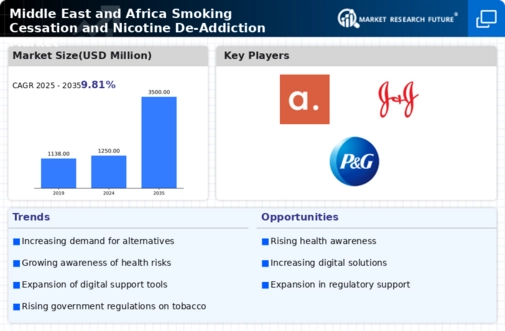Mea Smoking Cessation Nicotine De Addiction Size
MEA Smoking Cessation Nicotine De-Addiction Market Growth Projections and Opportunities
The dynamics of the Middle Eastern and African (MEA) Smoking Cessation and Nicotine De-Addiction market are determined by several market factors. One of such important factors is increasing awareness about negative health outcomes associated with smoking. As the MEA region becomes more concerned with public health and wellness, people understand that there is a need to quit smoking. This awareness is fueling the demand for smoking cessation aids and services, thereby promoting market growth.
Another crucial factor that affects MEA Nicotine De-Addiction and Smoking Cessation Market is government initiatives and regulations. Anti-smoking laws are being implemented in many countries in this region to fight against tobacco epidemic. Such initiatives include graphic warning labels on cigarette packs, campaigns for raising public awareness, and restrictions on tobacco advertising. These regulatory steps help create a favorable atmosphere for adopting smoking cessation solutions thus expanding the market.
Furthermore, the state of economy within MEA region influences the cessation market significantly too. People’s rising disposable incomes in certain regions make them willing to invest into their wellbeing as well as healthcare. This economic transition also results in higher ability to pay for such quit smoking products like nicotine replacement therapies or counselling services among others used by patients. Apart from that, an expanding middle-class population has emerged as one of its key consumer segments hence driving up sales across categories of smoking cessation products.
Factors related to culture also shape MEA Smoking Cessation and Nicotine De-Addiction market development too. In some societies found here, it is socialized so deeply that smoking has become part of their cultural fabric even though this reality is gradually changing due to emerging social norms that define perceptions about tobacco use urging people to stop consuming these substances finally. This entails increased strength against tobacco; people seek advice on quitting primarily because there is stigma around smokers which keeps growing every day also called “de-addiction” which should be sought by those who smoke cigarettes . These cultural shifts, as well as the desire to live healthier lives, have a direct influence on the overall market demand for smoking cessation products.
In addition, innovations in healthcare are facilitating growth within this market. In MEA countries, there is an increase in digital health solutions like mobile applications and online platforms created to help smokers in their quitting journey. Such technological interventions provide personal assistance programs that are coupled with monitoring tools and real-time support systems thus making recovery from smoking easier . The development of technology into this market is transforming its nature and opening up new prospects for overcoming nicotine addiction.
Therefore, smoking-related health issues are the primary driving force behind the demand for smoking cessation aids in the MEA region. An alarming rise in chronic diseases associated with cigarette use such as cardiovascular or respiratory problems has made it necessary to look right into the sources of these different types of illnesses. Healthcare practitioners advocate against tobacco consumption so as to prevent damage but these efforts have boosted sales of NRTs, prescription drugs against cravings from cigarettes (nicotine), counseling medications .







Leave a Comment